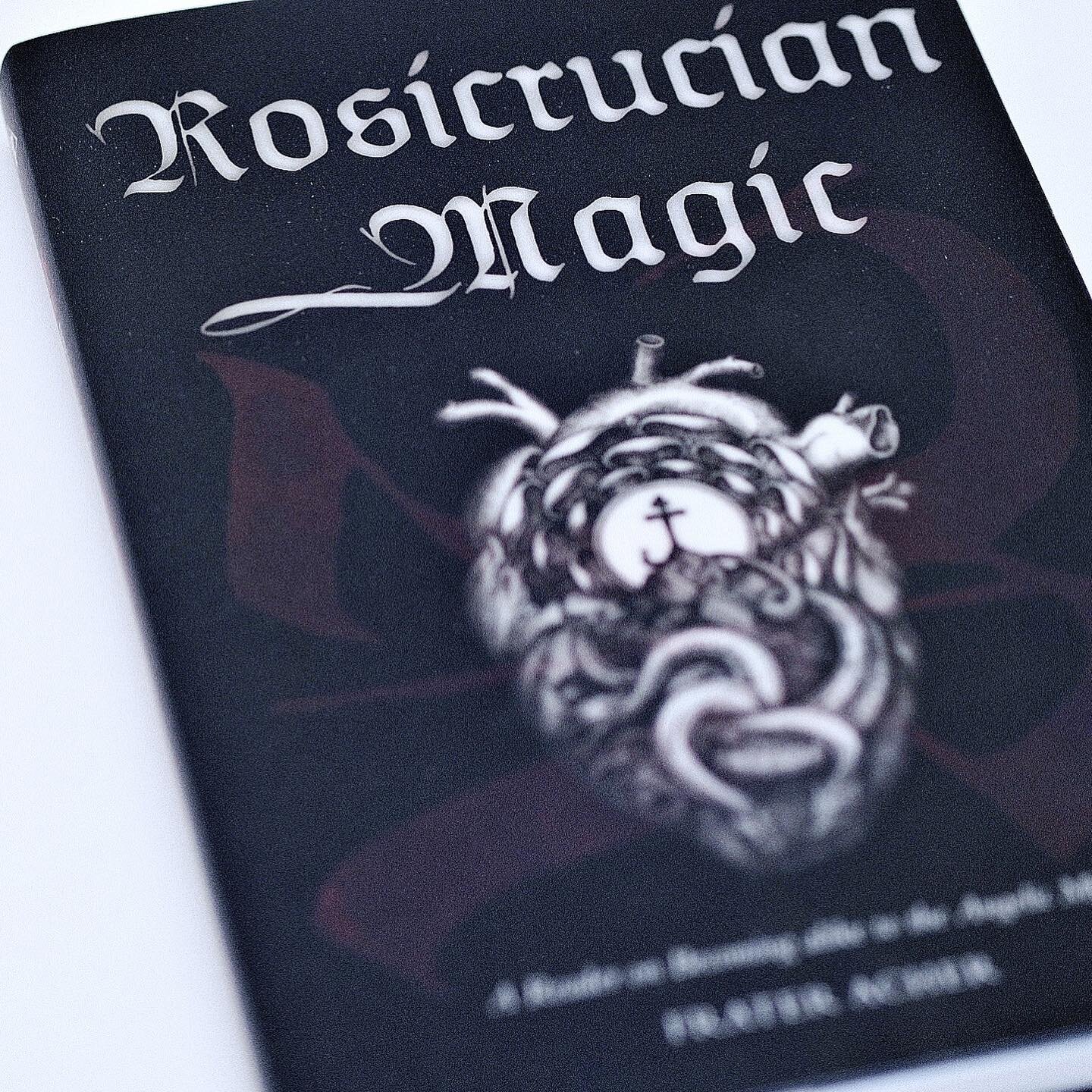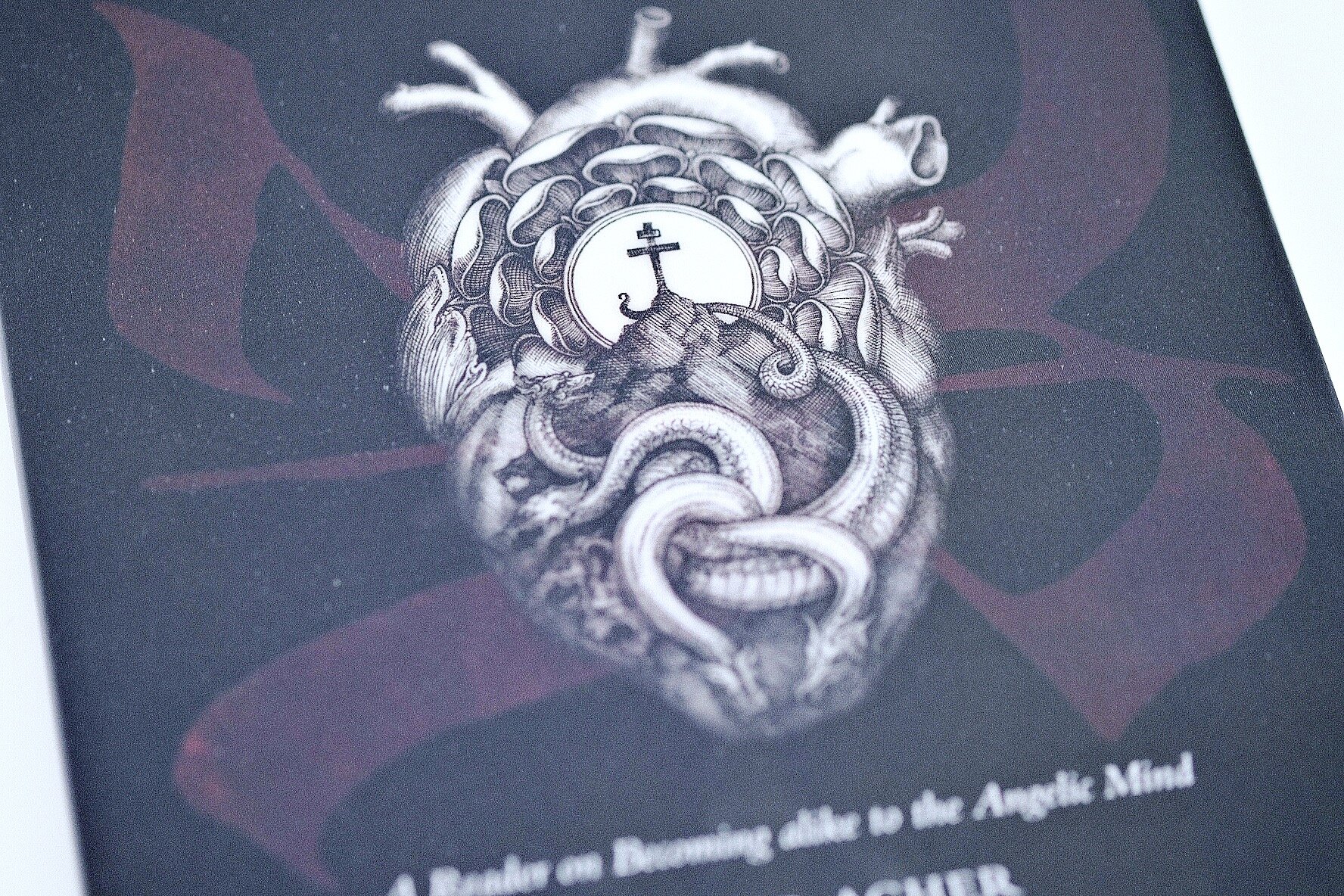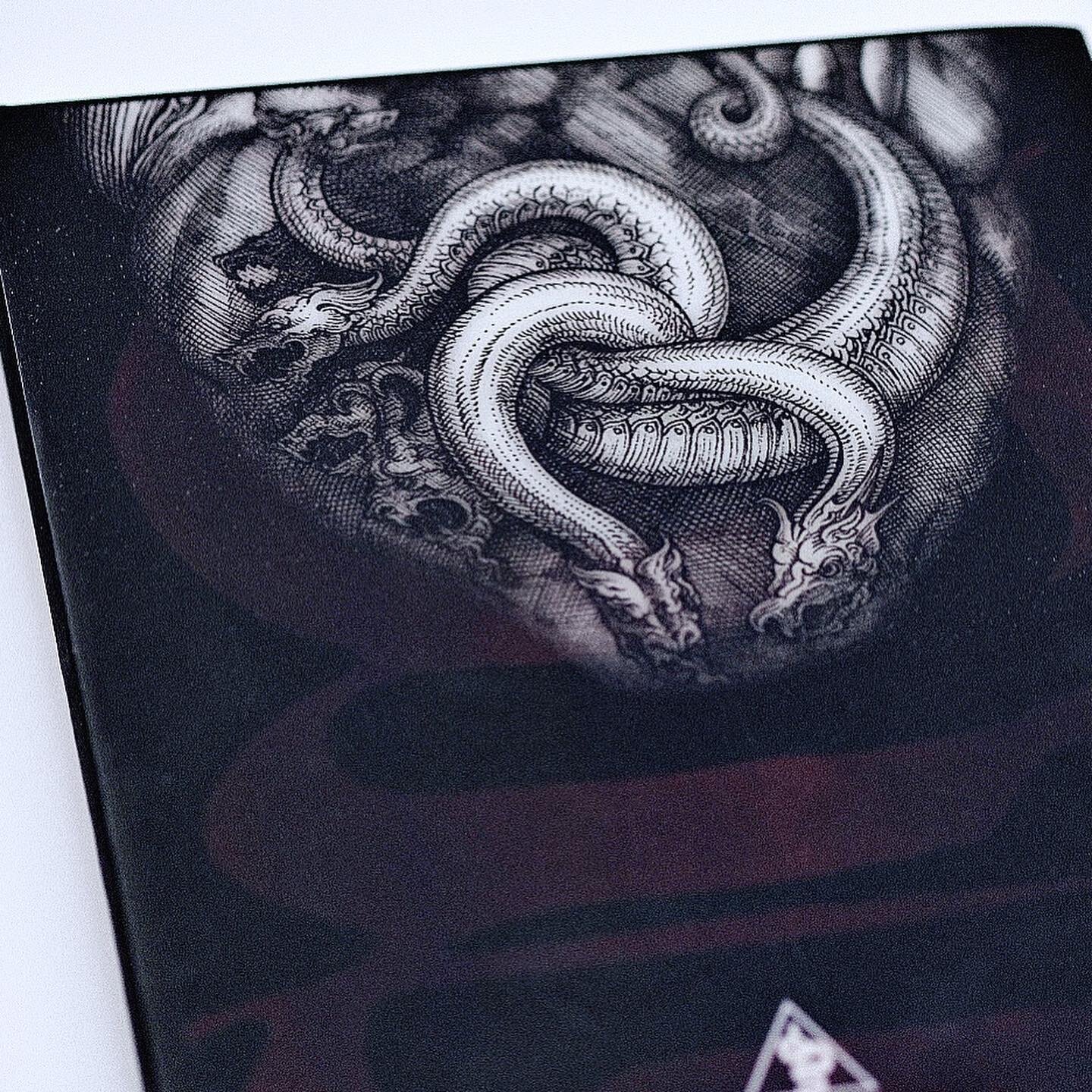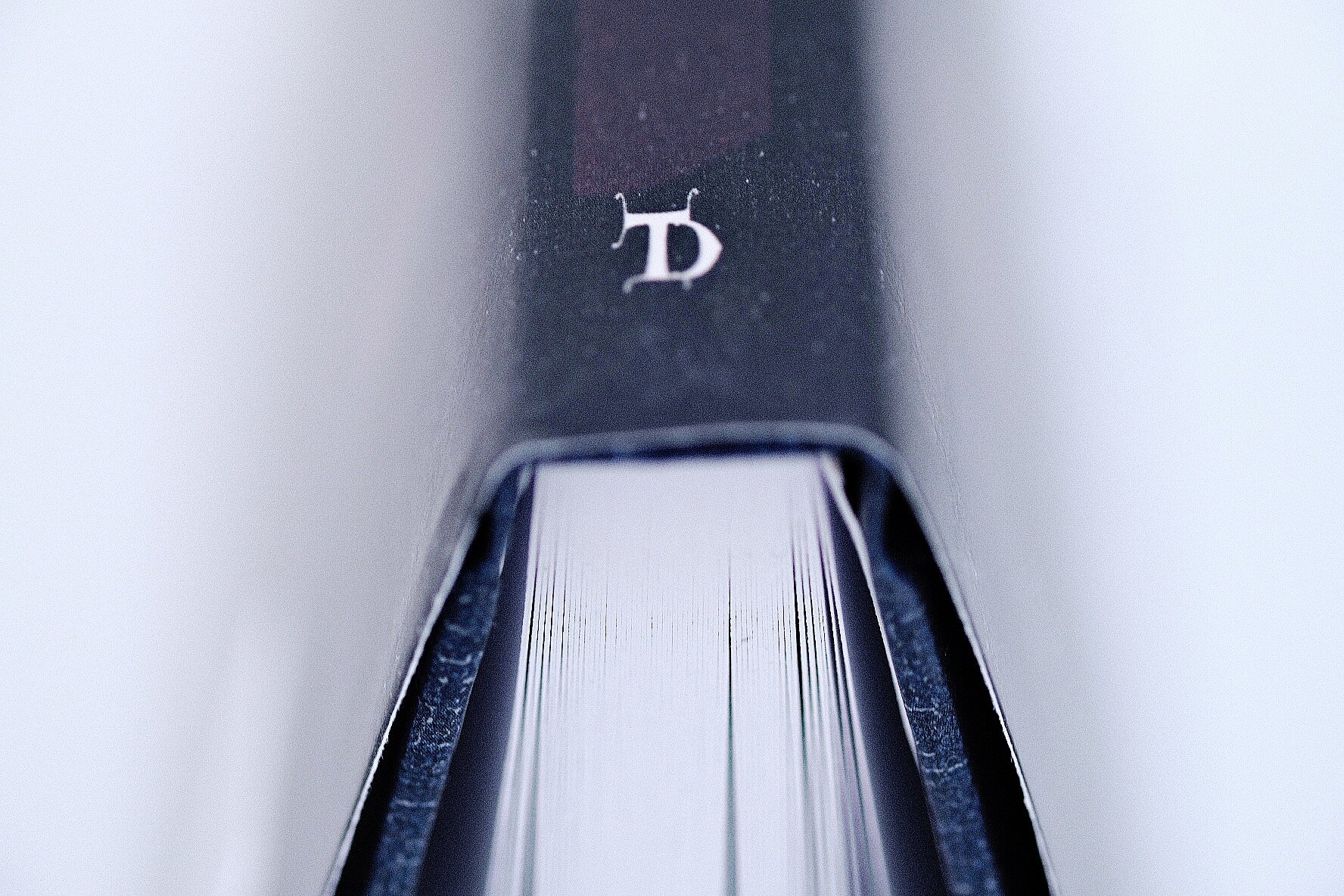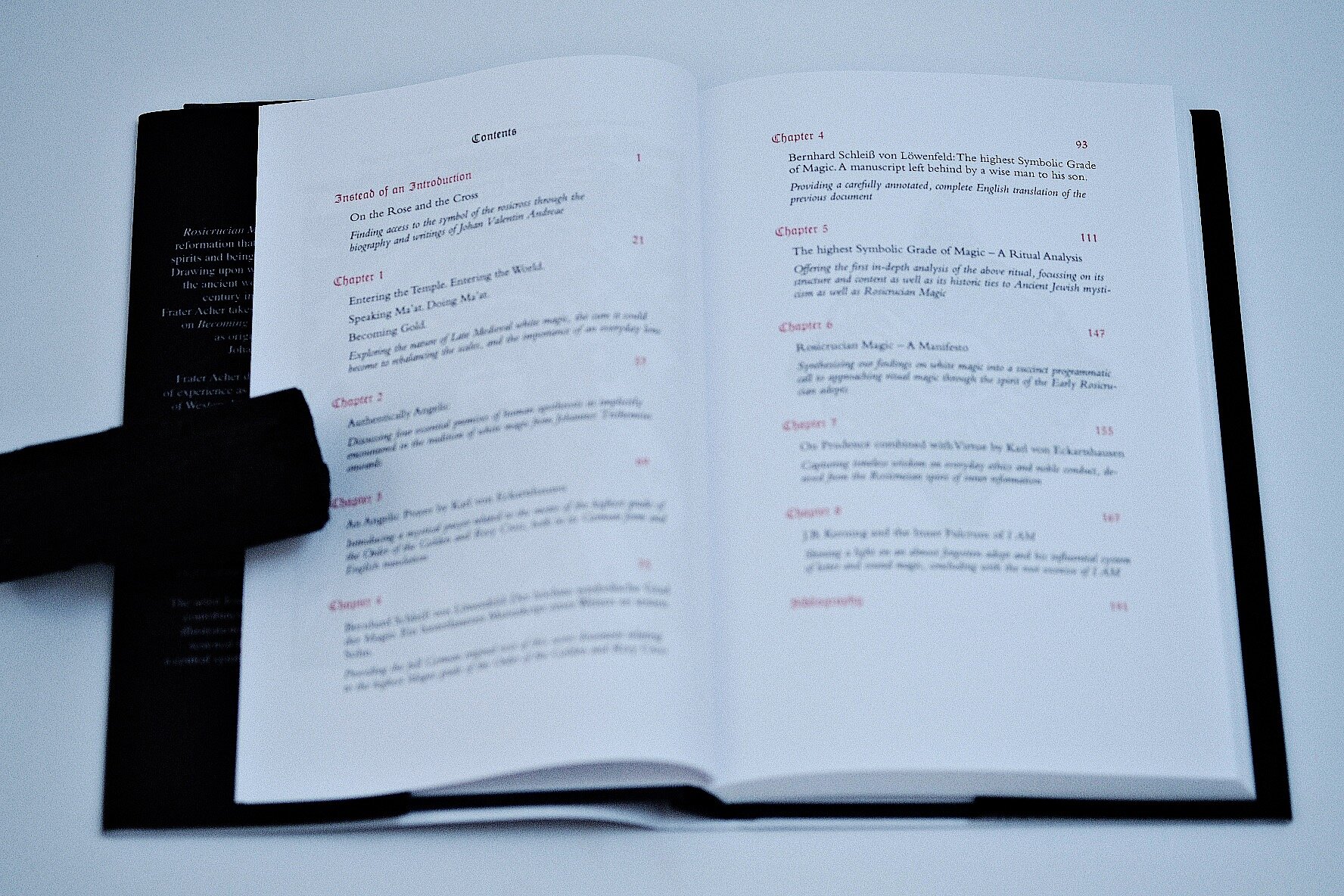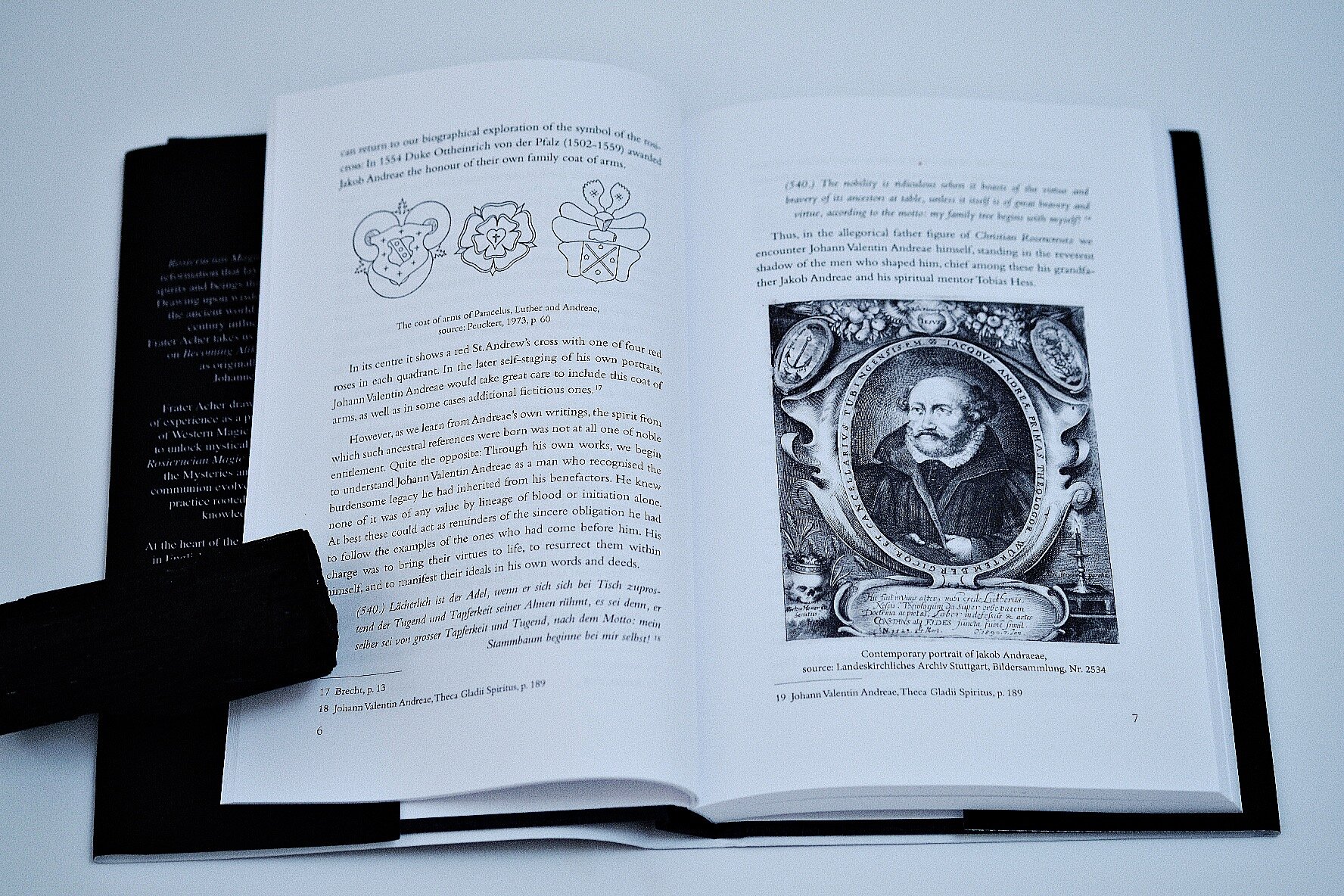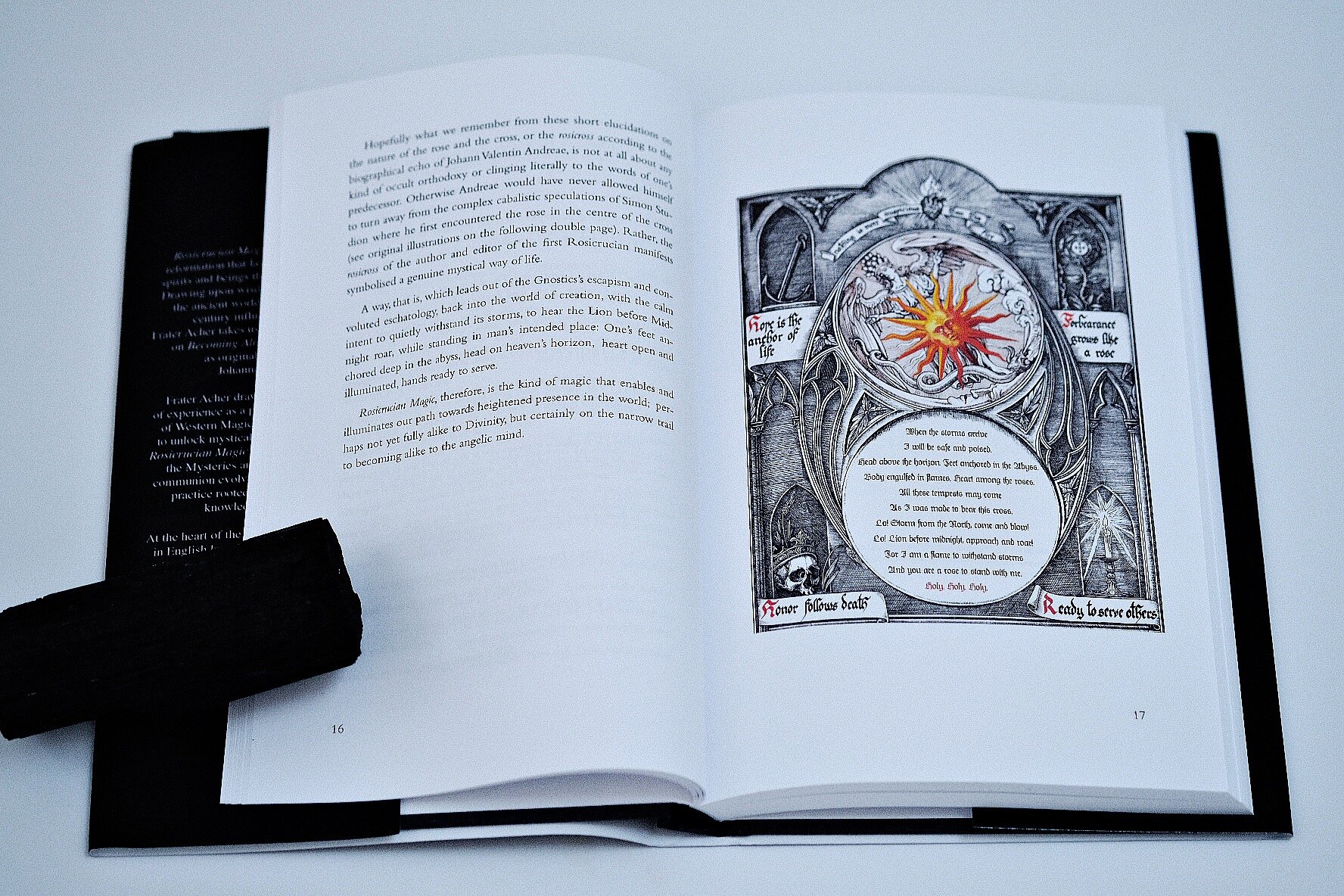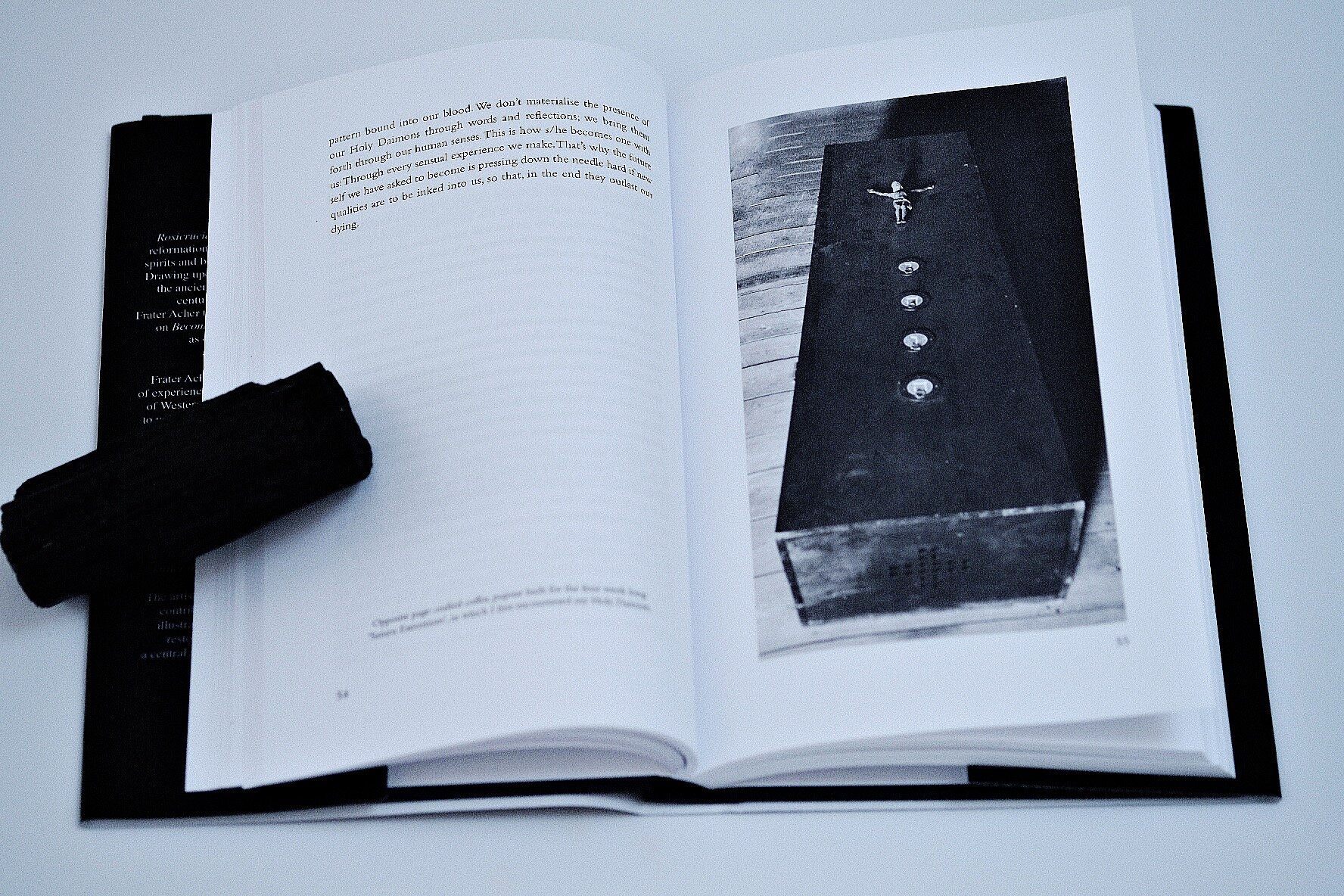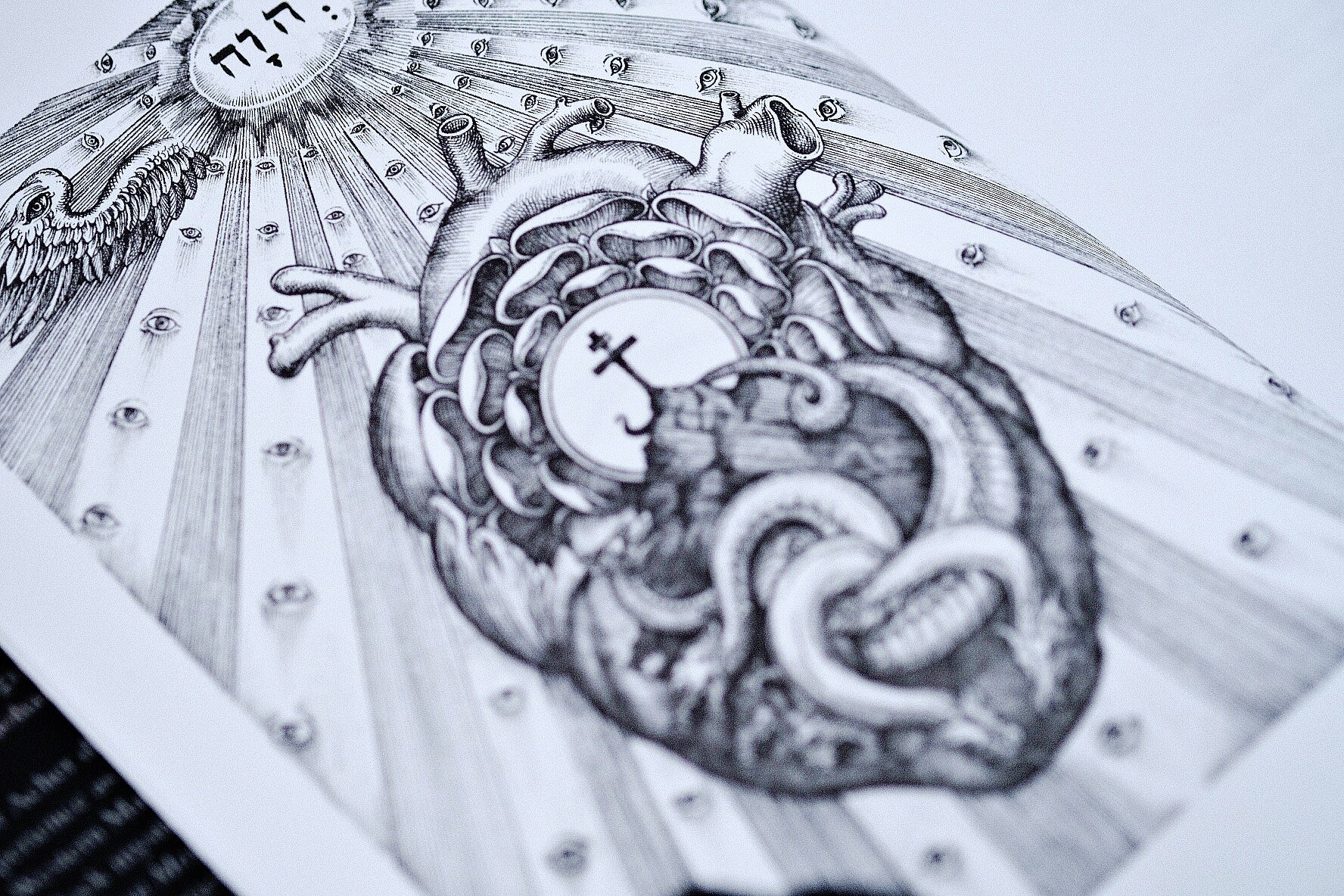‘Rosicrucian Magic’ by Frater Acher
Review: Frater Acher; Rosicrucian Magic: A Reader on Becoming Alike to the Angelic Mind, Exeter: TaDehent Books, 2021, ISBN 978-1-911134-57-2
Rosicrucian Magic is a text clearly written from a liminal space – a space between scholar and participant. Something of a mixed bag, the book does not always hit that all-important balance it prescribes. However, it is undoubtedly an intriguing and well-presented work for those with a foot in both the academy and the temple. Exquisitely illustrated by José Gabriel Alegría Sabogal and published by TaDehent Books, it is a book that embodies a broader academic discussion surrounding scholarly methodologies and the sticky issue of readings of Rosicrucian materials.
Underpinning the whole book is a subtle attempt to address fundamental questions surrounding the value of scholarly assertions made from those who inhabit both the role of the “shamanic-magical participate” and the historian. Can someone actively participating in a tradition be qualified to objectively appraise it historically or sociologically? What is the relationship between scholarship and personal experience? In the academic sense, this is not a question of mere bias. If one were to begin their historical studies by denying outright the intellectual validity of the Rose Cross and its marvellous, fantastical claims to antiquity, prophecy and intrinsic mystery as portrayed in the primary texts themselves, thereby adopting the positivist-reductionist or empirical-historical stance of explaining the links by merely external means i.e. political, economic or environmental – as some formal academics do – is this indicative of the kind of academic “neuroticism”, and intellectual insincerity renowned esoteric academic (and exception to the rule) Arthur Versluis claims it to be? If so, what does this mean then for our research or esoteric academic research in general? Shouldn't we, as objective religious historians, abandon a text’s more outlandish claims in the interest of scholarly diligence? Shouldn’t we psychoanalyse Rosenkreuz?
Rosicrucian Magic would suggest not. Frater Acher’s text is clear evidence to show Versluis’ argument is a valid one, and if ours is to be a productive study/practice, we must not abandon the texts. Neither scholarly nor initiatic approaches can abandon the texts. In the case of Rosicrucian Magic, it illustrates (albeit subtly) that certain vitally important historical links within the historical reception of Rosicrucianism and today’s practitioners would be altogether lost if our approach to the texts did not utilise the implementation of what Versluis called “sympathetic empiricism”. By which I mean a middle-position of empathy expressed in an empirical framework – a phenomenological position that those whom we would identify as “scholar-participates” naturally inhabit.
Indeed, if the scales of Maat are to find a balance, we must adopt an approach that is not wholly emic or etic. The greatest strength of Frater Acher’s text is that it seems to champion the ideas of Versluis and that it advocates a study and practice fully engaged in the kind of systematic dialectical application further advocated by the renowned scholar of esotericism, Wouter J. Hanegraaff. There is no doubt Acher aims to present an open discussion and one which has considerable emphasis placed on achieving what Hanegraaff describes as a dialectically formed middle-position of empathy (emic) expressed in an empirical (etic) framework, which thereby might enable us to reply to the call of Arthur Versluis for sympathetic “neutrality”. Wholly accessible to the scholar-participate (that is, the scholar participating in the initiatic moment), this “neutrality” can provide assertions with a certain analytical advantage over purely historicist examinations of the Rosicrucian tradition. Such an approach puts Acher’s text at an advantage over other such studies as he adopts the claims of the traditions themselves (and the claims belonging to their reception) as important empirical points of reference, something that must remain of the utmost importance in esoteric academic study. We must continue to respect the claims of the tradition as having been understood as a true living revelation, as a theology that must be understood on its own terms and by way of its subsequent contrasts in later historical developments. With sensitivity and personal testimony, Acher does just that.
In his postscript to his first chapter, Acher manages to avoid the artificial sun of modern-day reductionist or ideological fashions whilst discussing Rosicrucianism phenomenologically. Personally, the book is worth reading for this small section alone. Acher manages to give a sense of the metaphysical and cosmological self-understanding of the Rosicrucian traditions, which does not distort or misread the primary sources whilst presenting a sympathetic yet objective account of the tradition in a poetic and rather moving way. As Acher himself has stated, Rosicrucian Magic is a collection of essays exploring what it means to be human. As someone who is not a practitioner, I can appreciate this. I do, however, suspect I am not the target audience for this type of book.
Nevertheless, I find Acher successfully identifies and conveys the internal dimensions of Rosicrucianism with reference to and the inclusion of some truly wonderful primary sources. However, I was looking for more critical textual analysis in this study that would perhaps have helped with the balance I found a little lacking overall. At the same time, this is only my motivation for the reading the work. Not the motivation of the book itself.
Rosicrucian Magic suggests an almost universal requirement for a heightened state in which the participant's capacity to receive a spiritually hermeneutical engagement in symbolic knowledge is achieved. If we are to inhabit then the role of both academic and participate, we must meet this requirement sympathetically. Acher presents a number of translated primary sources. These are wonderful and a credit to the entire project. Acher’s translation of Bernhard Schleiß von Löwenfeld’s (1731-1800) The highest Symbolic Grade of Magic. A manuscript left behind by a wise man to his son is a joy. Sadly, Acher omits an archival reference for the MS and uses the largely discredited work of Dr. Bernhard Beyer (1879-1966) in his analysis. The text Der höchste symbolische Grad der Magie: Ein hinterlassenes Manuscript eines Weisen an seinen Sohn was originally published in Beyer’s volume five of Das Freimaurer-Museum (1925-1931) p. 215-227. It is suggested that the text forms part of the practical basis for the grade, “1º - 9º Magi” of the quasi-masonic order of the “Gold- und Rosenkreuzer Älteren Systems” (Gold- and Rosy Cross of the Ancient System). This is, unfortunately, not the case.
Acher frames these sources as a practical means by which different initiatory and visionary hermeneutical approaches might enlighten the reader in turning inward towards an experience of transcendence and the transmutational. Acher presents a universe which is itself a “book” to be “read”; God is known by his signature. Inspired by such luminaries of Karl von Eckartshausen and Johannes Trithemius, we can decipher the symbols which point towards God. Therefore, as we emerge from Plato’s hermeneutical cave, we can traverse a multitude of metaphors and symbols that help illuminate the levels of knowledge available to the human soul. In short, then, the sympathetic empiricism of the scholar-participate advocated by Acher critically helps the “logos become flesh”, whether it be in the temple, your attic or the academy.
Rosicrucian Magic is not a book focused on the organisational continuity of the Rosicrucian tradition in the historicist sense. No doubt an important consideration, Acher suggests, however, that the true linear heritage of the tradition was not a central concern to those involved. Indeed, the greatest strength that Rosicrucian Magic illustrates is perhaps that it is a shared experience that links the seventeenth-century reception of the Rosicrucian manifestoes with twenty-first-century Rosicrucianism. Such is the romance and allure of the Rose Cross that the requirement for speculative constraint is evident. As persistently evident as that requirement is, we are also compelled not to allow it to entirely obscure or fetter that sense of sympathetic engagement also required.
Rosicrucian Magic raises the question of what kind of balance must be struck in both the practice and the study of esotericism in general. Acher’s answer is in a phenomenological understanding of the Rosicrucian experience, of the initiatic moment, with all its intentionality, temporality and intersubjectivity, we might well find a sympathetic understanding – the internal connections the modern initiate is attempting to achieve. Quite rightly, Rosicrucian Magic is focussed on the social, ritual, experiential, doctrinal, mythic, ethical, and symbolic links, by which we come to understand sympathetically yet empirically the Rosicrucian tradition.
